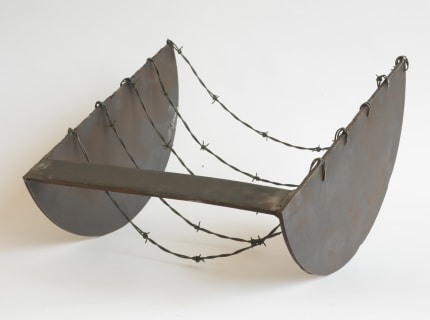How can we take pleasure in beauty, knowing the cruelty that goes on all around us? In this exhibition, Melvin Edwards asked this question in earnest, seeking an answer in the foundational American contradiction between our stated ideal of freedom and the violence underlying it.
The show was named for its largest work, Lines for the Poet, 1970/2023, a sculptural installation mounted in a corner of the room. There, lengths of barbed wire cascaded from adjoining walls. They met in the middle; these strands hooked into the long arm of a steel beam, forming a hammock-like support to suspend it just above the ground, where it thrust into space like the prow of a ship. Characteristically, the work merges abstraction with evocation. It distills gravity into a formal principle à la post-Minimal “lines in space.” But it does so in materials irredeemably associated with coercive enclosure and enforced separation—specifically, with the anti-Black brutality at the core of American history.
Edwards is best known for these barbed-wire installations, as well as for his ongoing “Lynch Fragments” series, 1960–, which includes wall-mounted, welded-steel assemblages composed of highly charged materials (chains, padlocks, scissors, knives, among other items). Recently, these sculptures have been featured in several high-profile exhibits at major museums. One might expect Edwards to bask in his well-deserved, albeit belated, recognition. Instead, he short-circuits our critical comprehension with surprising unseen work.
In 2019, Alexander Gray Associates showed “Painted Sculpture,” a pageant of freestanding welded works in primary colors: joyous experiments in axiality, balance, and solidity. These abstractions remind us of how certain forms tug us along in our everyday embodied experience, the way that an entrance seems to solicit passage, or a ladder climbing. Without Edwards’s usual politicized materials, these playful forms resist any didacticism.
Centered on its sculptural namesake, “Lines for the Poet” seemed like a return to more familiar terrain. But it was otherwise devoted to previously unexhibited works on paper—images with their own enigmatic significance. To make them, Edwards laid chains and wire atop unpainted sheets as he applied pigment. Using these implements as masking, he retained negative reserves in fields of luscious color. Sometimes soaked through the paper, sometimes dripped along its surface, sometimes loaded onto a brush and blasted with a spray bottle, this liquid tint felt sportive and joyous.
Saturation, gesture, and chromatics come together in idiosyncratic ways. One could, I suppose, compare the works with Helen Frankenthaler’s stains, Sam Gilliam’s dyes, or Jules Olitski’s sprays. But the specters of chain and wire are so essential to their effect—as forms as well as figures—that the comparison never gets off the ground. On the one hand, Edwards alludes to the vaunted Americanness of formalist painting, in which experimental paint application metaphorizes our national aspiration to freedom and autonomy. On the other, he reinscribes that story with the repressive violence at its core, instruments of cruelty appearing as spectral blankness, reminders of what US triumphalism must omit or disavow. These absences scar the surfaces like old wounds, never fully healed, that always throb in advance of rain.
The duality makes these works both arresting and disquieting. Edwards thus challenges us to reconcile the brutal evocations of their silhouetted tools with the rapturous satisfaction of their material qualities. Torment becomes beauty: not in the trite way of lemons yielding lemonade, but in a galvanizing contradiction between the aspirational modernism that the artist genuinely celebrates and the kinds of repression with which this tradition is complicit. Edwards probes the disturbing seductiveness of violence at the nexus of pleasure and pain.

